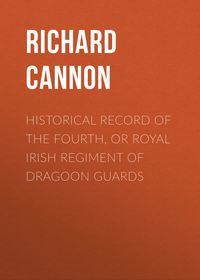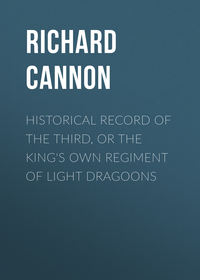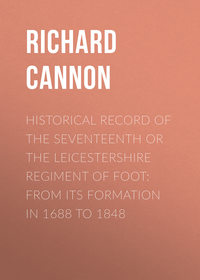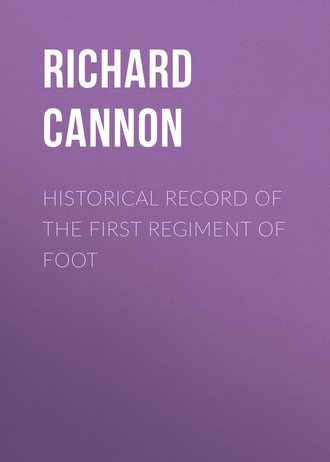 полная версия
полная версияHistorical Record of the First Regiment of Foot
London Gazette; and Military Records in the State Paper Office.
46
"Le Régiment de Douglas Escossois. Ce Régiment a servi plusieurs années en France, et s'y est fort distingué. Je trouve dans l'Ordonnance de Louis XIV., de l'an 1672, pour le rang des Régimens, qu'il étoit un des premiers." —Père Daniel.
47
Comte de Chamilly's despatch, in the original correspondence respecting the campaign of 1672, published in France.
48
See the Historical Record of the Life Guards, p. 43.
49
Histoire du Vicomte de Turenne par L'Abbé Raguenet.
50
Mémoires de deux dernieres Campagnes de Monsieur de Turenne en Allemagne.
51
London Gazette.
52
The Colonel of the Regiment, Lord George Douglas, was created Earl of Dumbarton on the 9th of March, 1675; but the French historians continued to designate the corps, "Le Régiment de Douglas."
53
In the order of battle for the French army on the Rhine in 1677, printed in the Histoire Militaire de Louis le Grand, the First Battalion of Douglas' Regiment appears formed in brigade with the regiments of La Marine, Couronne, and Vendôme, and the second battalion is posted between two cavalry brigades, on the left of the line.
54
"Captain Hume, who commanded our advance-party, showed great conduct and courage, standing several charges of the enemy's horse; and when the action was over, and he was upon his retreat to the main body, one of the Moors' chief commanders charged the rear of his party and overthrew him; but the Moor's horse falling, he was immediately killed." —London Gazette.
55
Tangier's Rescue by John Ross, fol. 1681.
56
Tangier's Rescue by John Ross, fol. 1681.
57
"This day the Scots and their grenadiers charged first, if there was any time at all between their charging: for, like fire and lightning, all went on at once." —Tangier's Rescue.
58
Tangier's Rescue.
59
Four colours were captured in this action; one by Dumbarton's Scots, one by the Admiral's battalion, one by the English horse, and one by the Spaniards. Three guns were also taken; two by the Foot Guards, and one by the battalion of Marines and Seamen.
60
The following return shows the loss sustained by the British troops in this engagement: —

61
The First Regiment of Foot Guards was for several years designated the Royal Regiment. There was also at this period a Royal Regiment in Ireland, which was sometimes styled Foot Guards. This corps adhered to King James II. at the Revolution in 1688. One battalion had previously arrived in England, and, being composed of papists, it was disbanded by William III. The men were confined a short time in the Isle of Wight, and afterwards transferred to the service of the Emperor of Germany. The other battalion fought in the cause of James II. in Ireland, until the surrender of Limerick in 1691, when it proceeded to France, and remained in the French service until it was disbanded.
62
The author of the account of this review here means two battalions of the 1st Foot Guards.
63
War-Office Records.
64
War-Office Records.
65
Sixteen field-pieces were employed. Nine were sent from the Tower of London, and seven from Portsmouth.
66
Lediard, and several other historians, attribute the preservation of the King's army from a complete overthrow at Sedgemoor to the excellent conduct of the Royals, in being under arms so quickly as to be able to hold the rebels in check until the other corps had time to form their ranks.
67
Fountainhall's Diary, p. 59.
68
War-Office Establishment Book.
69
Sir John Dalrymple, and several other historians who wrote many years after these events occurred, have mistaken the Royal Regiment of Scots Horse for the Royal Regiment of Scots Dragoons, now the 2nd or Royal North British Dragoons, or Scots Greys; but the latter regiment did not mutiny. The Scots Horse escaped to Scotland, and many of them joined the Highlanders in their resistance to King William III.; and the regiment was taken off the establishment of the army and was not afterwards restored.
70
List of troops sent to the Netherlands, in 1689, under the Earl of Marlborough: —
Second troop of Guards, now 2nd Regiment of Life Guards.
Royal Regiment of Horse Guards. One Battalion of the 2nd Foot Guards.
One Battalion of the Scots Foot Guards, now 3rd Foot Guards.
One Battalion of the Royal Regiment.
Prince George of Denmark's Regiment, now 3rd Foot, or the Buffs.
Royal Fusiliers, now 7th Royal Fusiliers.
Col. John Hales' Regiment, afterwards disbanded.
" Sir David Collier's " " "
" Robert Hodges' " now 16th Foot.
" Edwd. Fitzpatrick's " afterwards disbanded.
" Fergus D. O'Ffarrel's " now 21st Royal Scots Fusiliers.
71
This officer commanded the Grenadier Company of the Royal Regiment when it was raised in 1678; and frequently distinguished himself against the Moors at Tangier in 1680. In October, 1688, Lieut. – Col. Archibald Douglas of the Royal Regiment was appointed Colonel of a newly-raised regiment, now the 16th Foot; and was succeeded in December of the same year by Lieut. – Col. Hodges, from the Royal Regiment, who was killed at the battle of Steenkirk.
72
D'Auvergne's History of the Campaigns in Flanders.
73
D'Auvergne.
74
"The bravery of our men was extraordinary, and admired by all; ten battalions of ours having engaged above thirty of the French at one time, and Sir Robert Douglas, at the head of one battalion of his own regiment, having driven four battalions of the enemy from their cannon." —London Gazette.
75
Memoirs of Captain George Carleton.
76
The General History of Europe.
77
D'Auvergne.
78
The French brigades, which attacked the post occupied by the first battalion of the Royal Regiment, were those of Bourbonnois, Lyonnois, Anjou, and Artois, and King James' Royal Regiment, or Irish Guards, were amongst them. – (D'Auvergne.)
79
Official Records in Ireland.
80
Millner's Journal of the Marches, Battles, and Sieges of the British troops on the Continent from 1701 to 1712.
81
Portmore's, now 2nd or Queen's Royals, and Elsts, afterwards disbanded.
82
Now the 9th, 15th, 23rd, and 24th Regiments.
83
Now the 10th, 16th, 21st, and 26th Regiments.
84
The following Return shows the number of Officers killed and wounded in each British Regiment at the battle of Blenheim: —
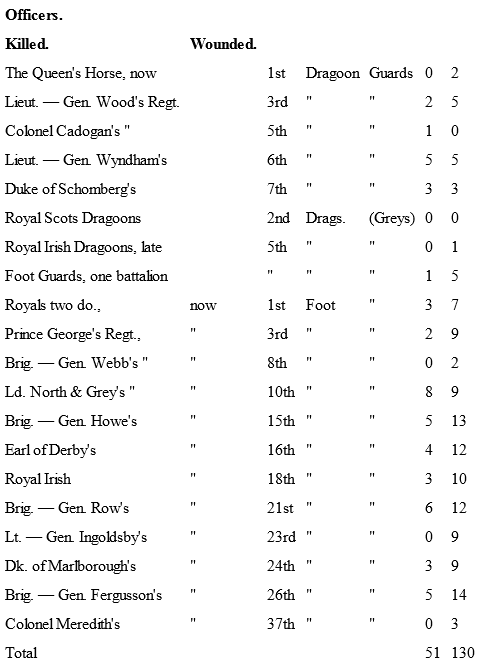
85
Milner's Journal.
86
London Gazette, &c.
87
War-Office Marching-Order Book.
88
War-Office Establishment Book.
89
Records of the Adjutant-General's Office.
90
Extract of a letter from an officer.
91
"The troops did honour to their country, particularly the 1st battalion of the Royal Scots, who were put to the hardest trials, behaved heroically, and suffered much." —Scots Magazine.
92
London Gazette, &c. &c.
93
In 1684, and for many years afterwards, the facing of the regiment was white.
94
His Majesty's commands were issued in October, 1832, directing that the colours of both battalions of the Royal Regiment should bear the same devices and distinctions.
95
South Carolina Gazette.
96
Return of troops engaged in the assault of Fort Moro, on the 30th July, 1762.

97
Stedman's History of the American War.
98
Naval and Military Memoirs of Great Britain from 1727 to 1783, by Robert Beatson, Esq., LL.D.
99
Lieut. – General Stuart's despatch.
100
Afterwards General Sir William Hutchinson, K.C.H.
101
Rainsford's Historical Account of the Black Empire of Hayti.
102
The Duke of York's despatch.
103
This officer rose to the rank of Major-General, and was killed before Bayonne in 1814.
104
Journal of Quartermaster-General Brownrigg, laid before Parliament.
105
Captain Mullen was on the Staff at Barbadoes, but volunteered his services on this expedition.
106
Now Lieut. – General Sir J. Stevenson Barns, K.C.B., Colonel of the Twentieth Regiment of Foot.
107
In this year (1811) was living at the village of Delmes, in Scotland, John Reed, aged 100 years; he was a private in the 2nd battalion of the Royal Regiment at the battle of Culloden, in 1746, and was in the battalion upwards of 40 years.
108
At a Scots corporation dinner, held in London on the 4th of May, 1811, on the health of the Duke of Kent, the Colonel of the Royal Regiment, being drunk, his Royal Highness rose to return thanks, and, in the course of his speech, said: – "My royal brother has been pleased to praise the regiment in which I have been employed, and have had the honour to command, and I too can bear testimony to the spirit and gallantry of the Scottish soldiers. From the earliest days, when I commenced my military life, it was always my utmost aim to arrive at the command of a Scots regiment, and to bring that regiment into action would have been the greatest glory I could have attained, as I am well convinced the officers and men would have justified my most sanguine expectations; their courage, perseverance, and activity, being undoubtedly such as may always be relied on; and they are always able and willing to do their duty, if not more than their duty." His Royal Highness took great interest in the welfare of the regiment; and he this year presented, by the hands of Lieut. – Colonel M'Leod, a gold medal to Serjeant Manns of the regiment, for the very meritorious manner in which he had educated upwards of 800 soldiers and soldiers' children.
109
This officer was shot through the hand whilst bearing the colours, the ball passing through the flag.
110
"Demerara, 20th of April, 1812.
"General Order.
"Major-General Carmichael cannot refrain from expressing his regret on the departure of the Royal Scots. The honourable testimony from Governor Bentinck and the inhabitants of the good conduct of the regiment for nearly nine years corresponds with the opinion the Major-General has formed of their correct discipline and military order in all respects, which evince the incessant attention of Colonel Stewart and the officers of the corps. He sincerely wishes them every happiness, and looks forward with the pleasing hope of meeting the regiment on future service.
(Signed) "A. Stewart, Brigade-Major."
111
"The Royals led the attack, on which occasion the distinguished gallantry of this corps was most conspicuous."
"The Royals refused to give way in the least, until General Hay received orders, through General Oswald, from General Graham, to retire, it having been found that success was physically impracticable, as the defences round the breach were not destroyed; and, from the showers of musketry, grape, hand-grenades, shells, and large stones, with which the attacking column was assailed, it appears miraculous that any escaped." —Extract from Sir T. Graham's despatch.
"The Royal Regiment proved, by the numbers left in the breach, that it would have been carried, had they not been opposed by real obstacles, which no human prowess could overcome." —Extract from Division Orders.
112
"Major-General Hay speaks most highly of the conspicuous gallantry of Colonel Barns in the successful assault of the coverlain, with the brave battalion of the Royal Scots.
113
Extract from General Orders.
114
The Americans were about 6000 strong, and the British only 1500: namely, Royal Scots, 500; 1st battalion King's Own, 480; 100th regiment, 450; one troop 19th Light Dragoons; and a proportion of artillery. —London Gazette.
115
The Americans were 5000 strong; the British were 2800.London Gazette.
116
Lieut. – General Drummond's Despatch.
117
General Orders.
118
A stone was placed in the church at Montreal, Lower Canada, with the following inscription: —
"In memory of Lieut. – Colonel John Gordon, commanding the 1st battalion Royal Scots Regiment of Foot, who departed this life on the 25th of September, 1814, in consequence of a wound received in action with the enemy in front of Fort Erie, on the 17th of the same month.
"This slab is placed by the officers of the battalion, to commemorate their high esteem for him as a man, and their respect for his character as a soldier."
119
This valuable and gallant officer had served many years in the Royal Regiment, in which he had a son, Captain George Hay, killed at the battle of Vittoria.
A monument was erected to his memory in the cemetery of the church of Etienne, Bayonne, with the following inscription: —
This tomb is placed here By the officers of the 3rd battalion, 1st, or Royal Scots Regiment of Foot, As a testimony of respect to the memory of The late Major-General Andrew Hay, Commanding the First Brigade of the Fifth Division of the British Army in France, Who gallantly fell on the morning of the 14th of April, 1814, In defence of the ground in which His body is deposited, Aged 52 years.
Near the north door of St. Paul's Cathedral, London, a monument has also been erected to the memory of this gallant veteran. He is represented falling into the arms of Valour, with a soldier standing, lamenting the loss of his commander.
120
"The 3rd battalion of the Royal Scots distinguished itself in a particular manner. Being removed from the centre of the 5th division, it charged and routed a column of the enemy. It was then formed in a square, to receive the cavalry, and though repeated attacks were made, not the slightest impression was produced. Wherever the lancers and cuirassiers presented themselves, they found a stern and undismayed front, which they vainly endeavoured to penetrate."Mudford's Historical Account of the Campaign in the Netherlands in 1815.
121
"Though charged six or seven times by an infinite superiority of numbers, the French cavalry never for an instant made the slightest impression upon the square of the Royal Scots."Narrative by an Officer who was an eye-witness.
122
"Whitehall, 13th December, 1815.
"His Royal Highness the Prince Regent, taking into His Royal Highness's consideration the highly distinguished services of Colonel James Stevenson Barns, Lieut. – Colonel of the 1st, or Royal Scots Regiment of Foot, Companion of the Most Honourable Military Order of the Bath, and Knight of the Royal Portuguese Order of the Tower and Sword, manifested by him on divers important occasions in the campaigns of Toulon, Corsica, Holland, Egypt, and during the recent arduous operations and splendid achievements of His Majesty's arms in Portugal, Spain, and France, and being desirous of conferring upon that officer such a mark of favour as may in an especial manner evince the sense his Royal Highness entertains of the intrepidity and valour displayed by him at the battle of Busaco, wherein, as Lieut. – Colonel of the Staff, he commanded a brigade; at the capture of Badajoz, on the 6th of April, 1812; at the victory of Salamanca, where, in leading his battalion to the charge, he was severely wounded; and his distinguished gallantry at the assault and capture of St. Sebastian, and the battles of the Nive, hath been pleased, in the name and on the behalf of His Majesty, to grant unto the said Colonel Barns, His Majesty's Royal license and authority that he and his descendants may bear the following honourable augmentation to the arms of his family: —
"A chief, thereon the representation of the curtain of a fortification; and above the words 'St. Sebastian,' as also a canton charged, with the representations of the gold cross presented by His Majesty's command to the said James Stevenson Barns, and of the badge of the Royal Portuguese Military Order of the Tower and Sword pendant from the ribands from which the said distinctions are respectively attached.
"And the following crest of honourable augmentation: —
"Issuant from a broken battlement, a dexter arm in armour, the hand grasping a banner inscribed 'St. Sebastian;' in allusion to the conspicuous conduct of the said Colonel Barns, on the 31st of August, 1813, when he gallantly led the 3rd battalion of the Royals, and assaulted and carried the curtain of the fortress, thereby eminently contributing to the ultimate capture of that important place; provided the said armorial distinctions be first duly exemplified, according to our law of arms, and recorded in the Herald's Office; otherwise His Majesty's royal license and permission to be void, and of none effect."
123
"Port Chatlerain, 29th November, 1815.
"Brigade Order.
"The 4th battalion of the Royals, the 42nd and 92nd regiments, are to march to-morrow morning for Meulans, on their route for Boulogne, to embark for England.
"Major-General Sir Denis Pack, cannot allow these corps to depart from his command without expressing his regret at losing them.
"The conduct of the 4th battalion, Royals, in camp and quarters has been, like that of the 3rd battalion and the two regiments, orderly and soldier-like; and he is confident, from the high state of discipline these corps appear in, they would have emulated their comrades in the 3rd battalion, had the same glorious opportunity been afforded them."
124
The following return shows the number of men drafted from the 4th to the other battalions on foreign service: —
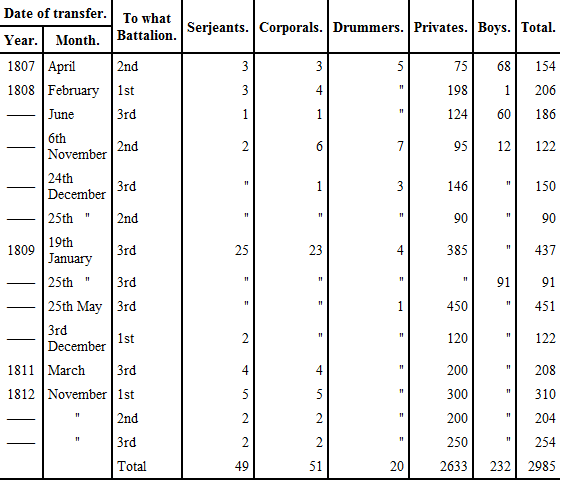
125
This officer was promoted to the rank of Major-General in 1830, and was drowned in the 'Frolic' steam-boat, between Tenby and Bristol, in March, 1831, with his wife, Lady Arabella M'Leod.
126
This officer was Deputy Adjutant-General to the King's troops, and he placed himself with the flank companies of the Royal Scots on the right, and encouraged the men by his example.
127
This officer received a severe wound while protecting his brother's body.
128
Captain Wetherall afterwards rose to the rank of Major in the regiment, and he wrote an historical record of his corps, which was printed in 1832, at the expense of the Colonel, the Duke of Gordon. Although there are some inaccuracies in the work, particularly as regards the formation and early services of the regiment, yet the record was as correct as could be expected from the limited information he was in possession of; and he evinced much laudable zeal and industry in its compilation. He followed the idea of Hamilton, who, in his printed sketch of the Royal Regiment, supposes it to have been a continuation of the Scots Guards at the French Court; but this has been proved to be an error. Major Wetherall died, while serving with the 1st battalion at Dominica, on the 7th August, 1833.
129
It is only an act of justice to state that such was the soldier-like feeling and esprit de corps of the men, after they were made acquainted with the duty that lay before them, that on their falling in with their companions in the camp at Neembolah at twelve o'clock on the night of the 17th of March, there was not one individual amongst them in the least intoxicated, or unfit for duty.
130
"The promptitude and energy with which the attack was made by the troops under the command of Lieut. – Colonel Fraser, of His Majesty's Royal Scots, reflect high credit on him and on all the officers and men employed. Our loss has been trifling; Lieutenant Bland, of the Royal Scots, is wounded. We are now in complete possession of the pettah, and the superintending engineer is employed in erecting a mortar battery to bombard the fort."Brigadier-General Doveton's Letter to Captain Stewart, Acting Resident at the Court of Doulat Rao Scindia.
131
"Yesterday evening a desperate and unexpected sally from the fortress was made upon an advanced post of our troops in the pettah; and it is with extreme regret I have to add that Lieut. – Colonel Fraser, of His Majesty's Royal Scots, who had been appointed by me to command in the pettah, was killed when in the act of gallantly rallying the party and keeping the advance in their position. The enemy was, however, immediately driven back, and compelled to retire again into the fort."Brigadier-General Doveton's Despatch.
132
Lieut. – Colonel Blaker's Mahratta War.
133
Afterwards Lieut. – General Sir Archibald Campbell, Bt. G.C.B., Colonel of the 62nd Regiment, who died at Edinburgh on the 6th October, 1843.
134
Now Major-General Sir Richard Armstrong.
135
"The attack upon Simbike was most handsomely led by Lieut. – Colonel Godwin, with the advanced guard of the right column, consisting of the flank companies of His Majesty's Royals, &c. &c."London Gazette.
136
This division consisted of 250 of the Royals, 270 of the 41st, 260 of the 89th, the light company of the 28th Madras native infantry, and 100 pioneers.London Gazette.
137
When Dr. Sandford and Lieutenant Bennett were captured, preparations were made to crucify them, but, after an hour's suspense, they were sent away from the river, and eventually forwarded in chains to the capital, a distance of 300 miles. On reaching Ava they were thrown into a loathsome dungeon, crowded with criminals and deserters, where the Doctor remained five, and Lieutenant Bennett ten days, with nothing but a little rice to support them, and even this was occasionally omitted. After being released from gaol they were kept separate. The Doctor was a prisoner at large in the house of an American missionary (Mr. Price), and the king's interpreter; and Lieutenant Bennett was placed under charge of a Burmese constable, and was in chains in a lonely situation during the troubled and fearful state of Ava. From the vindictive and sanguinary disposition of some of the Burmese ministers and chiefs, the lives of the prisoners were in constant jeopardy, particularly during the moments of excitement produced by disastrous intelligence from the army. The prisoners had also to dread that, through the influence and fury of the Queen and Priests, they should be sacrificed as a propitiatory offering to the Burmese gods. On the nearer approach of the British army, the Doctor and Lieutenant Bennett were frequently consulted on European modes of concluding treaties of peace; and the Burmese acknowledged they could not reconcile to their minds the idea that a victorious army, with nothing to impede its progress, should halt within a day or two's march of the capital, and terminate the war on conditions; this was not Burman custom. To use their own simile, they could not believe the cat with the mouse in her claws would refrain from demolishing it; and, therefore, they concluded the pecuniary demand of the English general was merely a ruse to obtain as much precious metal as possible, and afterwards as much territory would be retained as was deemed convenient. To raise their opinion of British faith, the Doctor engaged to convey a letter to the British camp, and to return of his own accord, and his re-appearance astonished the Burmese ministers, and whole population of Ava.


